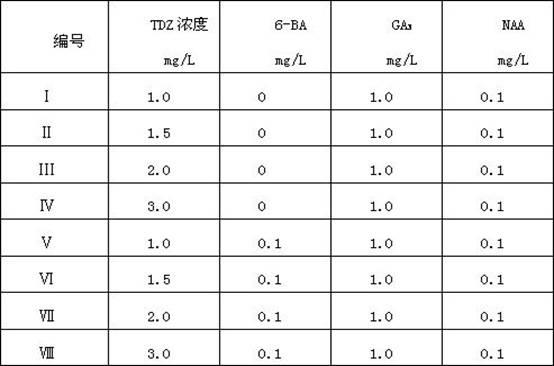Plant regeneration method by using giant tea rose stem segment as explant
A flower perfume and explant technology, applied in the field of plant tissue culture, can solve the problems of low seed germination rate, low survival rate, genetic improvement, etc., and achieve the effect of convenient collection, good protection and utilization
- Summary
- Abstract
- Description
- Claims
- Application Information
AI Technical Summary
Problems solved by technology
Method used
Image
Examples
Embodiment 1
[0026] A. Select the middle branches of the Chinese rose with full axillary buds, cut them into single-bud stems, sterilize them with 0.1% mercuric chloride for 8 minutes, rinse them with sterile water, and inoculate them in 1.5mg / L 6-BA + 0.15 mg / L NAA + 6.2g / L agar + 30g / L sucrose, and the MS basic medium with a pH value of 6.0, until the axillary buds germinated, and then inoculated on 1.0mg / L 6-BA + 0.01mg / L On the MS basic medium of NAA+6.2g / L agar+30g / L sucrose, under the conditions of 25°C, light intensity 2000Lx, and light time 14h / d, subculture was carried out for 25 days to obtain the free Bacteria;
[0027] B. Cut off the leaves of the aseptic seedlings of the large flower perfume rose obtained in step A, cut the wound transversely at the main vein of the leaflet, and inoculate the leaf back on the following callus induction medium: MS basic medium + 8 mg / L 2 , 4-D + 30g / L glucose + 2.5g / L phytogel, the pH value is 6.0, and cultured under dark conditions, the inc...
Embodiment 2
[0031] Steps A, C, and D are the same as in Example 1, except that the amount of 2,4-D in step B is 6 mg / L.
Embodiment 3
[0033] Steps A, C, and D are the same as in Example 1, except that the amount of 2,4-D in step B is 5 mg / L.
PUM
 Login to View More
Login to View More Abstract
Description
Claims
Application Information
 Login to View More
Login to View More - R&D
- Intellectual Property
- Life Sciences
- Materials
- Tech Scout
- Unparalleled Data Quality
- Higher Quality Content
- 60% Fewer Hallucinations
Browse by: Latest US Patents, China's latest patents, Technical Efficacy Thesaurus, Application Domain, Technology Topic, Popular Technical Reports.
© 2025 PatSnap. All rights reserved.Legal|Privacy policy|Modern Slavery Act Transparency Statement|Sitemap|About US| Contact US: help@patsnap.com

